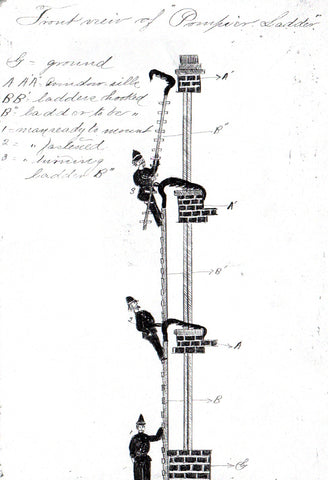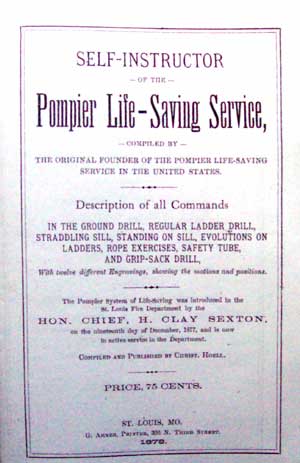Earlier this year while visiting a neighboring firehouse, I saw that they had displayed a very cool shadow box with all of the different knots used in our fire department. I really liked the idea and all of the other 'knot boards' I've seen. I thought that it would be nice to see a board with many of the different types of hooks used in the fire service around the country laid out in a 'knot board' style so the viewer would be able to see all the different variations next to each other. As far as I knew, I had never seen anything like this before.

The first problem was finding the right designer who would be willing to research and sketch the different hook variations and lay them out in an interesting manner. I chose Adam Weaver for this project because not only is he a very talented hand-letterer, he is also extremely talented at creating authentic and original illustrations. The only problem was that Adam is not a firefighter. He did not know how important this tool is to us or it's many uses. How could he feel as passionately as I do about our tools and our history?
Fortunately, I've learned that Adam is a life-long student of many subjects and after the Keys To The City project, I know that he relishes learning the finer details of a subject rather than the broad strokes.

First, we set out choosing which hooks to use. I tried to pick not only the most popular hooks, but ones that are unique to certain parts of the country. After we settled on the subjects, Adam got to sketching. We tried to never stray too far from the 'knot board' feel. I wanted the design to be educational as well as visually interesting.

In the end, I feel Adam created a design that is truly original and unique--a design that I hope most firefighters would be proud to own.
I want to thank Adam for being so patient and taking the time over these past months to learn so much about our world. We have become fast friends and I hope Hook and Irons can tempt him into creating more designs for us in the future.
As for me. . . Well I hope you guys dig all the care, dedication and time that went into this one. And, as I always say, 'Wear it with pride.' And this time, since we're offering a limited edition print, you can 'display it with pride' as well.


The Hook T-Shirt

Limited Edition Print
Christ Hoell
Like most firefighters, I have a fascination and respect for anyone who has ever climbed or worked from a Pompier Ladder. As buildings in the late 1800's grew in size and height, the ladder became a necessary tool for window rescues and scaling above the reach of ground ladders. The ladder, shaped like a question mark, is driven hook first into the window above the firefighter. The hook is pulled into the sill. Then the firefighter climbs to the window, straddles the sill, raises the ladder to the next floor and repeats the process until he reaches his destination. The pompier ladder is a simple, but effective tool for scaling buildings and saving lives.

The pompier Ladder was introduced to the United States in 1877 by Lt. Christ Hoell of the St. Louis Fire Department. He learned of the tool and the method while working for the Elberfeld, Germany Fire Department. The ladder had been invented about 50 years earlier in Germany and was already seeing wide use through the southern part of the country.
In 1873 (at the age of 27) Christ Hoell emigrated from Germany and settled in St. Louis where he was a stone mason until he was appointed to the St. Louis Fire Department. Early in 1877 two major fires in the St. Louis area prompted Christ Hoell to suggest and bring forth the idea of a 'Pompier Corps', to which he would train firefighters in the Pompier Ladder and other life-saving methods. By December of the following year Lt. Hoell had trained St. Louis FD Hook and Ladder 3 and 4 and the first pompier crew was put into service in the United States.

After training the St. Louis Fire Department, Christ Hoell was given leave to train FDNY in the use of the ladder and his other life-saving methods. New York's first rescue with the Hoell rescue device (pompier ladder) occurred on April 7, 1884 and was performed by John Binns of Ladder Co. 3. The last rescue occurred on December 15, 1967. Gene Dowling of Ladder Co. 25 made the daring rescue in 30+ mile per hour winds. Both the first and the last rescues performed with the pompier ladder earned the James Gordon Bennet Medal, the highest honor bestowed to FDNY firefighters.
Many people owe their lives to this odd ladder and the daring firefighters who scaled the sides of buildings to save victims. The FDNY carried the pompier ladder on their trucks until July 11, 1996 when it was decommissioned. The Boston Fire Department still uses the ladder as part of its recruit training.
This design was hand drawn by Tom Lane using a turn of the century style that we believe matches the heart and soul of the ladder. The lower left portion of the shirt displays the St. Louis FD logo with the year that Christ Hoell introduced the ladder to America. We hope you like this new design as much as we do.
-George













